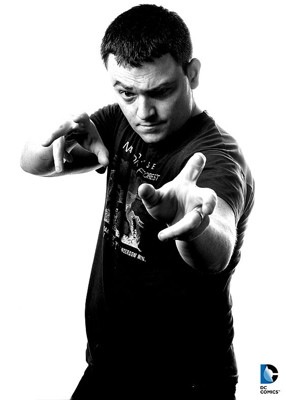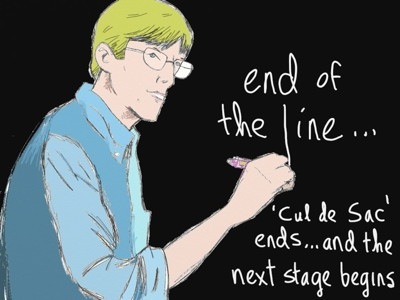This is the third year of our Comics Industry Person of the Year poll, and the winner was pretty much a landslide. Every year we ask the participants in our survey to name who they thought was the person who made an impact or set the pace, and to comment anonymously (or on the record) and it was a clear choice this time out. With many people saying it was the Year of Image, Image publisher Eric Stephenson was the runaway winner—and the Saga team of Brian K. Vaughn and Fiona Staples were definitely the Team of the Year, with a significant number of votes.
PERSON OF THE YEAR ERIC STEPHENSON
For Stephenson it was a year of triumph, as The Walking Dead swarmed the sales and ratings charts as an unstoppable army — the comic and collections topped both the comics and graphic novels charts for the year. But there was a sense of creative revitalization at Image that captured the attention of creators and readers alike. Saga, the return of Vaughan to comics, became an instant must read, but Image also hit with the obvious—comics by superstars such as Grant Morrison, Jonathan Hickman and Ed Brubaker—homegrown hits—Chew, Mornings Glories, Thief of Thieves—and tastemakers like Brandon Graham, who hit with the quirky Extreme remake Prophet and his own King City saga. Stephenson even put himself on the other side f the ledger, with a return to writing with Nowhere Men, which features art by Nate Bellegarde and Jordie Bellaire.
Everyone was talking about Image books in 2012, whether it was new books like Mind the Gap and The Legend of Luther Strode or old favorites like Savage Dragon and Spawn.
With the continued importance of maintaining corporate brands at both Marvel and DC, “getting an Image book” was a goal for more and more creators in 2012, and Stephenson was there to greet them at the door. His controversial blog posts—and a spiffy new ad campaign that spotlighted creators—set the tone for defending the importance of creators owning their work outright, especially when the Before Watchmen controversy threw issues of controlling one’s catalog back into the spotlight. Although he put his blog on ice, Stephenson remains outspoken in message board postings and interviews (we’ll have one with him later today.) With concerns over making a living from books that creators control always foremost, Stephenson was a visible cheerleader for making the periodical business model working for creators. 20 years in, Image was setting the pace again.
Our yearly poll skews heavily towards independent creators, but Eric Stephenson clearly made his presence felt in this year, making him the perfect choice for 2012’s Comics Industry Person of the Year.
Here’s what commenters had to say about Stephenson’s year:
— Image is becoming what Vertigo was in the 90s, the place where you go to do cool stuff. He’s proved that looking after the talent pays long-game dividends.
— Eric Stephenson for steering the Image Comics ship the way he’s doing. I don’t know, with any certainty, where this industry is headed and where the growth might outshine the losses going forward. But I appreciate the diversity Image is fostering, and I’m really proud and excited to be the least bit associated with it.
— Eric Stephenson. Image is more relevant than it’s been in some time, and it’s not just the Kirkman show anymore. Saga is probably the best new title of the year and a sales breakout. Fatale people know about. Prophet is very under-appreciated. I’m counting 12 titles over 10K in the November sales estimates. Brain K. Vaughan is back in comics. Brubaker and Phillips took a break from Icon. Jonathon Ross brought Bryan Hitch with him. Grant Morrison and Derrick Robertson did a mini-. The young man has done some recruiting and the books are selling enough for some tangible creator profits.
— Eric Stephenson. I don’t even know him that well but he led the charge of Image Comics into a new era. Definitely deserves credit for everything that he’s done.
— Eric Stephenson. Image went all out for its big anniversary, and it looks like it was a hugely successful year. Sales were strong, the critical reception was great, and Stephenson was a regular presence in the media, offering his (very worthwhile) insights on the industry. Just look at all of the big names that gravitated to Image last year. That says a lot.
TEAM OF THE YEAR: VAUGHAN & STAPLES
Coming up next in the voting, as mentioned, was another team from Image’s strong bench, Brian K. Vaughan and Fiona Staples, who set the tone for what a new Image book could do with Saga. A stunningly realized SF epic that sets star crossed romance, intergalactic intrigue and crazy alien races as a backdrop to petty marital squabbles and worries over child raising, it hooked readers from page one. The monthly comics were top of the chart sellers for many retailers, and the collected edition of the first six issues was the #1 book for several.
If Vaughan’s triumphant return was no surprise, Staples emergence as a storyteller was a revelation, creating a gallery of immediately iconic characters with imagination while never losing sight of the small human moments in an interplanetary clash of magic and science.
Reached for comment on their win, Staples responded
Wow! It’s been a giant year for me, and I’m so grateful for the support. It’s been a joy seeing people respond to Saga in such a huge way. Thank you!
And Vaughan said:
Whoa, thanks, Beatniks! That’s a real honor. SAGA is very much a team effort, and Fiona and I couldn’t have made the book without our letterer/designer Fonografiks, Boss Man Eric Stephenson, who worked so hard to help transform the landscape of creator-owned comics forever this year, and the whole family at Image Comics. Thanks for making us look good, team.
Here’s what industry people had to say:
— Brian K Vaughan— arguably, SAGA is the flag-ship title for the New Independent Age, and BKV (with Fiona Staples) is leading the charge of creator-owned comics away from DC and Marvel.”
— Brian K. Vaughn and Fiona Staples. — It’s nice to see them both return and meet such high expectations. Not only with such exciting and well-accepted work, but also in a position where they control and create it themselves. SAGA, even without the recent retailer FOC side story, has been a great example in the comic industry. It shows, once again, that Image Comics is the home for creative talent to find their vision and for that work to find new readers. It also cements Image as not just the place for The Walking Dead. 2012 has been a banner year for Image and BKV & Staples puts a foamy head on that beer. In other words, the beer was already good (The Walking Dead, Fatale, Morning Glories, Enormous, et.) but the cream of crop is still on top and still on tap for more. SAGA makes the point that Image’s current direction is not chalked up to luck.
While Image ruled the roost, there were other newsmakers who garnered a lot of comment. Here’s what they had to say.
Karen Berger
The Executive Editor/Sr. VP’s exit from Vertigo was definitely the story of the year for many, and her lasting achievements are still foremost as she ponders her next move. It was the end of an era, but perhaps the start of another.
— Karen Berger is the Industry Person of the Year for 2012 due to the retrospective feel her resignation set in motion toward Vertigo. Fans came out of the woodwork to talk about the ways in which Vertigo comics had shaped their development as readers or as creators and the impact that Vertigo has had on the overwhelming popularity of genre comics in the 90’s and 2000’s. Vertigo has been one of those lines that obviously impacted both mainstream and indie comics, even encouraging the reprint market of EC comics. Karen’s guidance over such a long period can be equated with Vertigo’s persistence from its most expansive heyday to its struggles, but determination to continue in recent years. Then there are the iconic writers and artists who have become big names under her guidance from Neil Gaiman to Grant Morrison and many, many more. Would they have reached the audience they deserved without her? By all accounts she had quite a vision for the future of genre comics and without Berger, it’s possible that more indie publishers like Dark Horse wouldn’t be where they are today. That’s the true test of influence, when an expansive concern for the future of comics reaches far beyond the professional’s own publishing company. Praising Karen is not to downplay the good work her successors may still do to continue her legacy, but she deserves plenty of honor and recognition for a monumental career.
Her leaving DC really brought into focus the enormous legacy she’s created. I think DC is going to be a very VERY different publisher without her. I think it’ll continue to become the Batman and Superman store…with very little innovation.
— Karen Berger. Not just for the work she did with Vertigo since its formation but in the last year especially. Karen has always been a staunch supporter of creator-driven projects and pushing the medium in new directions. Vertigo faced a lot of challenges as DC Comics transitioned fully to the “New 52.” I think she shepherded the imprint through those changes about as well as anyone could as she ended her tenure there. I look forward to what she does next.
Garnering equal mentions were two polar opposites of what can be called “comics culture”, Chris Ware and Joss Whedon (although when we were putting this together we noticed that they kinda look alike.) Few even needed to explain their votes—Ware and Whedon are such singular creators that just mentioning their names conjures their achievements.
Ware invented a new storytelling with Building Stories, a Cornell’s Box of precious comics that make the reader experience life at is most desperate and human. It was an object heavy enough to break every glass ceiling of cultural impact that comics had yet to shatter, winning universal acclaim and setting off what is sure to be endless critical analysis. Ware has taken his artform where no one else has gone, but there’s more to come.
Whedon’s achievement was the exact opposite—by making an Avengers movie that broke box office records while keeping the funny/thrilling spirit of Marvel Comics foremost he proved there are no thresholds of mass media success that comics-related characters can’t cross in this era. Whedon’s the king of the hill at Marvel/Disney now, and he’s stayed as true to his storytelling roots as anyone can in the perilous realms of Hollywood.
While the focus on this year’s voting wasn’t Big Two comics, one creators was mentioned several times: Scott Snyder, whose work on the Batman franchise revitalized it and topped charts.
— Scott Snyder is industry person of the year. Scott struck a near-perfect balance between high profile top selling mainstream stories and creator-owned projects. He’s a model for creators to look to, in terms of quality storytelling and the intergration of personal and commercial work.
— Scott Snyder. Not only because he writes a good Batman comic, not only because his American Vampire is scary and good, not only because he made Swamp Thing into a solid mid-tier hit (which absolutely no one expected), not only because after the mostly incredibly craptastic handling of Superman by DC since the relaunch I’m looking forward to reading his Superman book and not only because he “encouraged” DC to have Becky Cloonan draw Batman #12 thus breaking down glass ceiling over seven decades old, but also because he’s remarkably good with fans, supportive of his fellow writers and in a year where I’ve seen so many creators act like asshats on social media he hasn’t and, in fact, he actually listens to criticism. Snyder has a passion for comics backed by talent and that’s always a good thing.
A couple of returnees from last year’s list also had support.
Robert Kirkman, 2010’s Person of the Year, was in the mix again.
— Robert Kirkman. Partly for the success of Walking Dead, but even more because he is becoming famous to “civilians” purely for being a comic book creator. I can’t think of anyone besides Stan Lee that’s true for.
— Robert Kirkman. What he did with Walking Dead this year was nothing short of phenomenal.
And finally, a sentimental favorite for some, Cul de Sac’s Richard Thompson, whose work this year was sadly cut short by his ongoing battle with Parkinson’s disease forced him to give up drawing and seek radical medical treatment – a process movingly covered by Michael Cavna here. Thompson’s work is a humane and humorous extension of the man himself, and the comics world is pulling for him.
— Richard Thompson. He’s the best strip cartoonist we’ve seen in decades, something acknowledged by no less an authority than Bill Watterson. He’s not going to be producing new work for a while, sadly, but I’m looking forward to his return to comics, whenever it happens and whatever form it takes.
While these were some of the year’s biggest personalities, many other were mentioned and lauded. Here’s a sample
The Indies
— Annie Koyama. There are so many people in the independent comics publishing world who deserve to be recognized as “person of the year.” I am selecting Annie Koyama because of her continued–seemingly tireless–dedication to providing support to artists who may not have otherwise been acknowledged as prominently in the comics field.
— So-called boutique publishers like Nobrow and Koyama Press, who feel like they occupy the space once taken up by Highwater, Alternative and Top Shelf ten years ago. Putting out quality books by young cartoonists.
Bill Kartalopoulos
— Dude seems to be everywhere, doing everything. He runs comic cons, he runs panels, he edits books, he writes reviews, he runs a comics press…but does he sleep?
— He not only conceived the programming for two of the most beloved comics festivals in 2012, SPX and BCGF, but he launched his own imprint, Rebus Books, with its first title. That’s a pretty impressive year for anyone, if you ask me.
— Tom Spurgeon. I think we’re damned lucky to have him
Publishers and industry figures
—Charlie Kochman, Sr., Editor, Abrams.
— While Jeff Kinney’s Diary of a Wimpy Kid has changed the fortunes of Abrams and has also opened up the traditional market for more great kids graphic novels, Charlie is the guy who understood immediately that Kinney had a great story to publish.
— Gina Gagliano marketing director of First Second Books.
— She pretty much got half the company’s publications this year on the New York Times Bestseller list singlehandedly. Who else can say that for graphic novels?
Scott Dunbier, Senior Editor, Special Projects, IDW.
— The artist’s editions are one of the few things everybody agrees upon as a magnificent initiative.
Hank Kanalz, SVP Vertigo & Integrated Publishing for DC Entertainment.
— With his digital-publishing corner of the empire becoming increasingly important to DC, and Vertigo now reporting to him, Hank’s footprint is already large. If Jeff Robinov leaves Warners — as seems likely — and Diane Nelson (and possibly Geoff Johns) go as well, Kanalz is a Warner Bros. veteran who might wind up with an even bigger role to play.
Dan Franklin (head of Jonathan Cape in the UK)
Chris Roberson
Mark Siegel
Creators
Gail Simone
— She and artist Jim Calafiore raised $117,660 on Kickstarter for their “Leaving Megalopolis” graphic novel. That’s incredibly impressive and inspirational and should be a wake up call to everyone working in comics. There are new ways of making a living forming before our very eyes, and that’s a very good thing.
Jeff Lemire
— UNDERWATER WELDER is just an unbelievable masterpiece, and he’s done such great books, one after the other–and is such a complete master of the art, the words, and the whole separate skill of strategic yet emotional storytelling–so I’d vote for him. — Jennifer Hayden
Joe Hill
— I’m going with the creator who most impressed and entertained me with his work, writer Joe Hill.
Raina Telegemier and Dave Roman
— Robert Kirkman would be an obvious choice – The Walking Dead has dominated the graphic novel bestselling charts, and the TV series keeps getting high viewership and good reviews. However, I say Raina Telgemeier, for showing that books written for younger readers (Smile and now Drama) can be national bestsellers for all ages, and her husband Dave Roman, whose Astronaut Academy series is also popular with younger readers – these two are total rock stars in my school library.
Dan Slott
I think Dan Slott has really raised the bar here. — Tony Lee
Ryan North.
He rewrote the rules of Kickstarter, in large part by offering more to his backers as the campaign progressed. On day one of the “To Be Or Not To Be” campaign, US$25 would get you physical and electronic copies of a book with 30 B&W illustrations, and some temporary tattoos. By day 30, that same 25 bucks gets you the original print/electronic book with 110 color illustrations, a second physical book, four more e-books, a bookmark designed for choosable-path books, and a stack of stickers, plus knowing you contributed to 400 copies of the original book being provided for free to libraries and universities. Instead of maximizing personal profit, North plowed the funds back into making the product better and better; he epitomizes the symbiotic relationship between creator and audience, rewarding interest in his work by creating more; it’s much more work for him, he doesn’t make as much money as he could have, but his priority is in maximizing the value he provides. Bravo. Along the way, he spoke to a few obscure media outlets like The Guardian, The Takeaway, WGBH, and the CBC, while achieving more than 2900% of his original goal.
Gary Friedrich
Johnny Ryan
The Legends
Moebius.
— Hands down. Let’s remember a legend.
Stan Lee
Now at 90 years young, he’s still out there making deals and creating visibility for the geekdom that is all based in comics. He may no longer write, edit or publish, but his omnipresence and love of the spotlight is good for the entire business of comics. — Joe Field
— Look as good at 90 you will not.
Steve Ditko
–He is 85 years old and continues to produce the comics he wants to see. Even years after from his retirement from any sort of mainstream work. Anytime I am unmotivated or lazy I think about Ditko still sitting at his desk churning out the pages. I love him.
Walter Simonson
— Not only did we finally get to behold THE JUDAS COIN [years in the making], but IDW was smart enough to respect the master’s genius in the form of Alien – The Illustrated Story (Original Art Edition), and Walter Simonson’s The Mighty Thor: Artist’s Edition. I had the great honor to study under Walter in 1985 when I was but a grasshopper and I’m still learning from him today. He even showed everybody he could still draw a monthly book when he collaborated with Brian Michael Bendis on THE AVENGERS. The older Walt gets, the better he gets. There are only a handful of cartoonists who can do that. Walter Simonson is a living comix god and an inspiration to us all. — Dean Haspiel
And assorted folks in and out of comics proper:
Kevin Feige
— The evolving Warner movie master plan, Marvel Now, even the New 52 — Feige’s Marvel cinematic universe has re-written the DNA of contemporary comics-related media. The Avengers’ success guaranteed that it will have ample room to grow.
— Kevin Smith of Comic Book Men, is helping to legitimize comics culture on a new level – making it okay that books become TV series or movies. Bringing new intelligence to the adult-boy phenomenon, and pointing out cultural critique embedded in this work.
Daniel Petrocelli, the lawyer for DC in the Superman lawsuits.
— Not only has he shifted the momentum in this historic litigation, but his direct hits on creators’ rights crusader Marc Toberoff make him the hero of the multinational corporate beach. Toberoff’s loss in the Kirby case might have been seen as a circumstantial fluke if Petrocelli hadn’t succeeded in calling Toberoff’s ethics and business model into question. However, Petrocelli’s biggest influence will be on cases we might never see. Creators, heirs and lawyers heartened by the Siegels’ success in 2008 now have ample incentive to think twice about whether exercising termination rights is a never-ending battle that’s worth fighting.
David Steinberger, CEO of Comixology
— The company may not monopolize the trade like it did, but a tripling of sales probably has to be notable.
…and finally…
The Readers
— The consumer, the reader, the fan…without them it all goes away.
— Without any irony or sarcasm I have to say that the comics industry person (or rather, persons, if we can borrow from Time magazine) of the 2012 is the comic fan. With the comic book movies we’ve seen (especially the achievement of The Avengers, with several movie franchise characters coming together to team up, just like they do in comic books), The Walking Dead’s continued TV dominance, sales of digital and print comics up by an astounding amount and even comiXology’s own achievement of surpassing the 100 millionth download of comics and graphic novels, this could not be a better time to be or become a comic book fan. And of course none of these things could have been done without current comic fans. Their continued (and growing!) devotion to the comics medium allows for creators to keep telling amazing stories that wouldn’t exist otherwise and the fans are the driving force that keeps our favorite heroes alive, flourishing and breaking ground in mediums like film and television. I look forward to every fan growing the comic industry even more in 2013. – David Steinberger (Comixology)




















Boooooo! It should have been me…. lol ;)
WE NEED TO DO WAY INSTAIN MOTHER!
Really? After Stephenson decided to insult nearly every retailer?
Comments are closed.